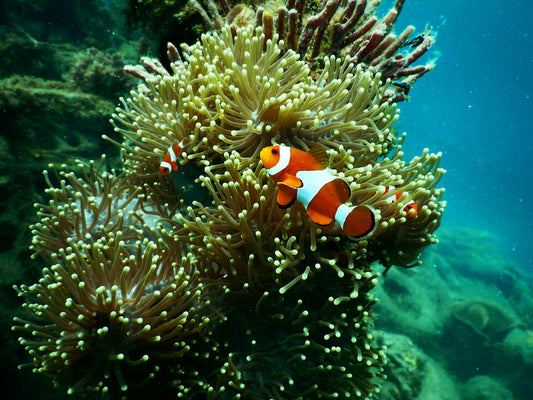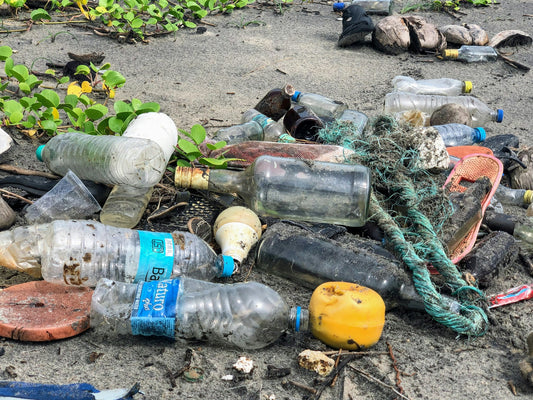Share
Maintain Your Sparkling Smile
How important is brushing your teeth for you?
What a strange question to ask, right? Brushing our teeth is such an essential part of our daily routine that we don't really think about it.
Oral hygiene is a crucial aspect of overall well-being and all of us (hopefully) brush our teeth twice a day.
But have you ever thought about what happens to your toothbrush after you throw it away?
Or have you ever wondered how toothbrushes are produced and if the plastic you chew on alll the time could be harmful?
Find out in this article!
In our new series "The Dirty Truth", we explore everyday items and the role they play in the big theme of pollution.
Today: Toothbrushes.
We'll unpack plastic toothbrushes for you. The production, the usage, and the disposal. Finally, we have great natural alternatives for you.
Toothbrushes in Numbers
It is estimated that one billion toothbrushes are thrown away used in the U.S. every single year.
Globally that amounts to 23 billion.
On average we individually use 300 toothbrushes in our lifetime. After all, dentists recommend that we replace our toothbrush every three to four months.
Most of those toothbrushes will be made from single use plastic.
To understand the environmental impact, let's first understand what these plastic toothbrushes are made of.
Toothbrush Production
Toothbrushes contain two main components, the handle and the bristles.
Historically, toothbrushes were made from animal bones for the handle and animal hair for the bristles.
However, modern toothbrushes mainly rely on plastic.
The handle is usually made from Polypropylene, often with a rubber component to it. Most bristles are made of Nylon.
Both plastics rely on non-renewable fossil fuels and emit potent greenhouse gases during production.
In fact, the whole plastic supply chain has been criticised for its terrible impact on nature. A lot of environmentally harmful steps happen, before you hold your toothbrush in your hands.
Starting with the extraction of natural gas and crude oil, plastic production also relies on chemical processes, such as polymerization and ethane cracking.
It uses harmful substances like terephthalic acid and ethylene glycol. These chemicals, along with catalysts like antimony, toxic emissions like nickel, ethylbenzene, ethylene oxide, and benzene, and byproducts like acetaldehyde, pose serious health risks to humans.
Environmental consequences include air and water pollution, soil contamination, and threats to ecosystems and humans.
If that weren't enough, plastic production emits 2 billion tonnes of greenhouse gases annually which is approximately 5% of global greenhouse gas emissions.
If you're interested in more detail about the dangers of plastic production, check out the first article in our "Dirty Truth" Series here!
Toothbrush Usage
While dentists advocate for regular toothbrush use, traditional plastic raise health concerns.
The petroleum-based materials in toothbrushes may expose users to potential health risks. After all, you are rubbing plastic against your teeth daily.
It is hard to find detailed studies on the health impact of plastic toothbrushes and the topic needs to be explored futher.
Nonetheless, some sources show that plastic toothbrushes are a potential health hazard. The main two reasons for that are:
- plastic bristles are a potential breeding ground for bacteria, funghi and microbes
- some toothbrushes may contain synthetic chemicals like BPA linked to health issues like cancer, hormone disruption, and heart diseases.
- the mechanic abrasion from brushing teeth can release microplastics, which cause many health issues when entering your body.
Check out our article about microplastics in the human body and its effects for more details.
Luckily, there are many different alternatives available that limit your exposure to harmful plastic. But before that, let's look at the impact after your plastic toothbrush has reached its end of life.
Toothbrush Disposal
Considering the sheer volume of 23 billion toothbrushes discarded annually, it is hard to grasp the environmental impact.
Assuming 20 grams per toothbrush, envision the weight of more than 3400 Boeing 777 in toothbrushes being thrown away every year.
Unfortunately only a small percentage of toothbrushes are ever recycled and most of them end up on the landfill or even in nature.
Plastic toothbrushes are one of the items that take the longest to disintegrate. On average it can take more than 500 years to break down.
That means every toothbrush ever created is still in existence and will be for your grand grand grand children.
The even worse part is that many toothbrushes end up in our waterways, because of flawed waste management and littering. Nothing describes the impact better than the devastating experience of a researcher on a remote pacific island.
The concerned founder of Sustainable Coastlines Hawaii tells a similar story.
It is not uncommon to pick up 20 or more toothbrushes during a single beach cleanup.
We've seen that the envrionmental impact of plastic toothbrushes is staggering.
- plastic production releases toxins and produces significant greenhouse gases
- the usage is a potential source for microplastic and chemicals exposure,
- their disposal is polluting our ecosystems and killing wildlife
It's about time we explore eco-friendly alternatives and make the switch!
Eco-Friendly Alternatives
Depending on your preference, there are fantastic options available that reduce your environmental impact and reduce your health risk from plastic toothbrushes.
All of them come with a Bamboo handle. Bamboo is a fascinating material that beats plastic by a landslide when it comes to sustainability and health.
1. Bamboo Toothbrush With Horse Hair Bristles

This truly a zero plastic option. The handle is crafted from sustainable bamboo and the bristles are made from steryized horse hair.
The horse hair comes from cruelty-free sources in Monglia and you can rest assured that no horse had to die for it.
In fact, horse hair has a long standing tradition in Mongolian Nomad families and has been used for centuries in craftsmanship.
2. Bamboo Toothbrush With Three Different Bristle Options

We All Have a Voice - Let's Use It!
In the fight against plastic pollution, we all have a voice.
By voting with our wallets, we can force more producers to offer sustainable options. Toothbrushes are not an exception for that.
Let's all make the switch today and replace our plastic toothbrush with one made of bamboo!









2 comments
Hi Kristen,
thanks for your comment. Unfortunately the toothbrush you bought is not an outlier. It is very common for toothbrushes to be completely made out of plastic, handle and bristles.
Finding sustainable bristles has been a challenge for a long time.
While there are other alternatives, none of them are perfect. The most common alternatives are:
1. Castor bean oil bristles: castor bean oil is a bioplastic made from the castor bean plant, which is biodegradable in the industrial compost. They have been It is the most sustainable vegan option available on the market right now.
2. Bristles from animal hair: There are toothbrushes with horse hair or pig hair bristles. The bristles are cleaned and disinfected, before usage. This is the only fully compostable option on the market, but they are not vegan and raise questions about animal welfare. While we offered toothbrushes with horse hair bristles a while back, we decided to take them off our marketplace due to customer feedback and our own tests. We are working on finding another alternative with animal bristles.
Cheers,
Lars
I just bought a toothbrush here in Japan because I thought it would be healthier. When I got to hotel, it said bristles were made of saturated polyester. I don’t think that is a good thing. Your advice would be appreciated. Thanks!